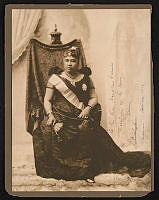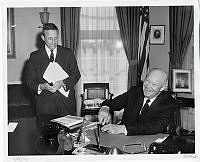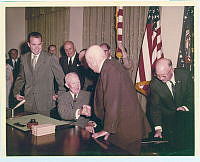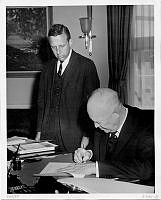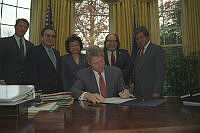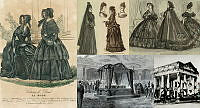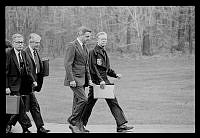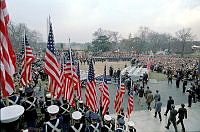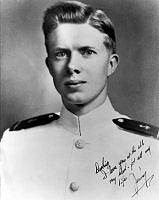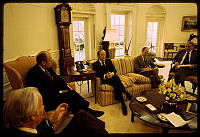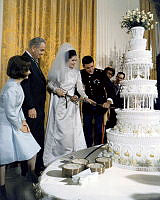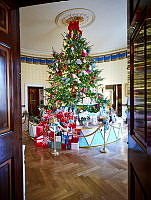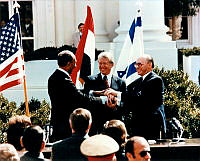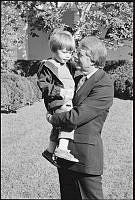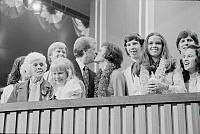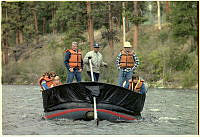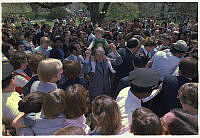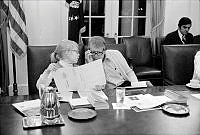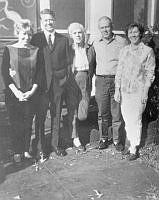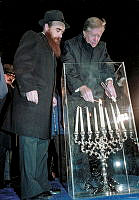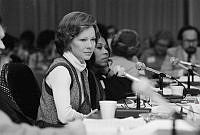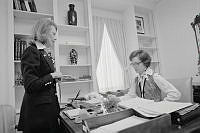Notable Prominent Neighbors
Personalities of St. John's Church
Copyright © June 01, 2012 White House Historical Association. All rights reserved under international copyright conventions. No part of this article may be reproduced or utilized in any form or by any means, electronic or mechanical, including photocopying, recording, or by any information storage and retrieval system, without permission in writing from the publisher. Requests for reprint permissions should be addressed to books@whha.org
Saint John’s Church, Lafayette Square, is the oldest building still in use in the neighborhood of the White House—except for the White House itself. Constructed during 1815–16 under the supervision of the noted architect, Benjamin Henry Latrobe, it first opened for services on October 27, 1816, and was consecrated on December 27, 1816.1 From its inception, the church has had among its members, and occasional attendees, some of the most distinguished and notable civilian and military leaders of the United States and of Washington, D.C. Just before its consecration in 1816, Saint John’s set aside a pew for the use of the president of the United States on those occasions when he chose to attend services.

This 1816 sketch by the architect Benjamin Henry Latrobe shows the secular neoclassicism of the original design.
Saint John's ChurchEvery person since James Madison who has held the office of president of the United States has attended at least one service at Saint John’s Church. And through the nearly two centuries since its founding it has been a place where important marriages, funerals, and special services have been held. The church’s location so close to the White House off Lafayette Square has ensured that it, and its attendees, would be an integral part of the story of the nation and its capital city. As Senator Henry Cabot Lodge noted at the celebration of Saint John’s centennial anniversary: “To describe all that has happened within sight of this spot, all that this church has seen, looking across the square, would be to tell in large part the history of the United States.”2 Part of that history is illustrated by the following vignettes of some of the notable members and personalities associated with Saint John’s Church.

Stephen Pleasonton, c. 1850, who rescued the heart of the American Archives during the British invasion in 1814.
Library of CongressStephen Pleasonton
While several veterans of the War of 1812 became known for their military career, and were members of Saint John’s Church,3 one civil servant present during the British invasion of Washington in August 1814 has almost been forgotten. His name is Stephen Pleasonton. In August 1814, Pleasonton was serving as a senior clerk to James Monroe, the secretary of state. When Monroe, after a horseback ride scouting British troop movements, concluded that Washington faced a serious threat of invasion from the British forces, he sent a rider with a message advising the clerks at the State Department in Washington to secure the “Books and papers” of the department. After receiving this message, Pleasonton purchased “coarse linen” which was made into bags to transport the significant books, documents, and papers in the possession of the State Department to a safe location. Among these were the Declaration of independence, the Constitution of the United States, the papers of the revolutionary government and of the government that followed, up to 1814, the secret journals of the United States Congress, not then published, General George Washington’s correspondence and his commission, the text of the treaties concluded since the revolutionary War, and laws and other official records held by the State Department since the nation’s independence.4 While Pleasonton was in the process of assembling these records, he encountered General John Armstrong, the secretary of war. Secretary Armstrong dismissed Pleasonton’s efforts as “unnecessary alarm,” for Armstrong believed the British were not likely to attack Washington. Pleasonton responded bluntly that those in the State Department held a different view, that “it was the part of prudence to preserve the valuable papers,” and that he intended to do just that.5
After loading the documents into carts he had obtained, Pleasonton took them to a gristmill owned by Edgar Patterson, located 2 miles above Georgetown on the Virginia side of the Potomac river, beyond Chain Bridge. Once there, Pleasonton concluded that because a nearby foundry could produce cannon and shells, the mill site was too vulnerable to potential British attack, so he procured some wagons from nearby farms. He then had the official papers and documents placed in these roadworthy wagons and hauled them to Leesburg, Virginia, 35 miles from downtown Washington. He stored the materials inside a vacant building, locked the doors, and gave the keys for safekeeping to a local official. Exhausted from his long trip, Pleasonton then retired to bed early that evening of August 24, 1814.6 Through these efforts, Pleasonton saved many of the historic documents of the young nation’s founding period from certain destruction. When he returned to Washington on August 26, he found the State Department building from which he had removed them in smoldering ruin.7
Pleasonton joined Saint John’s as an original member in 1816 and attended it until his death in 1855. He served for decades as fifth auditor of the treasury, an important civil service position. in July 1849, he was a pallbearer at the funeral of former First Lady Dolley Madison. Mrs. Madison had moved back to Washington, D.C., after her husband’s death in 1836. A Quaker by birth, as a widow she was baptized and confirmed in Saint John’s Church, which she first attended when her husband James was president. There her funeral service was held. Thus, although Stephen Pleasonton is not widely known today, the organizers of Dolley Madison’s funeral were well aware in 1849 of the important service he had rendered in saving a key part of the nation’s heritage. They honored him by having him serve with the more famous leaders of that day as a pallbearer for Mrs. Madison, a beloved representative of the early years of the young republic.8

Charles Wilkes, c. 1860–65, was a Pacific explorer and map maker.
Library of CongressCharles Wilkes
One of the most intriguing naval officers of the mid-nineteenth century was Admiral Charles Wilkes. Wilkes and his family became members of Saint John’s Church in 1844. Wilkes had been tutored in private schools and graduated from Columbia University in New York City. He then joined the U.S. Navy and was appointed a midshipman in January 1818.9
Wilkes’s most notable contribution was with the U.S. Exploring Expedition. From 1838 to 1842, six ships under his command circumnavigated the globe, mapped large sections of the Pacific, Pacific Northwest, Australia, and Antarctica, and returned with thousands of scientific specimens that formed the foundations of the Smithsonian Institution. in the course of this voyage, Wilkes discovered and charted a large section of Antarctica, laying the basis for U.S. interest in the area. Because Wilkes mapped a large portion of Antarctica, that region is officially named “Wilkes Land” after him.
Following the expedition’s return to the United States in 1842, Wilkes began a roughly twenty-year effort, drafting and superintending the publication of its findings. in 1845 he authored and published the initial five-volume work, titled Narrative of the United States Exploring Expedition. He authored two additional published volumes, one on meteorology and another on hydrography, while monitoring the production of several other volumes written by subject specialists.

This 1853 photograph shows how the building was remodeled to be more traditionally church-like, as opposed to Latrobe's original sketch.
Library of CongressAt the commencement of the Civil War, Wilkes returned to sea duty. During his service in the U.S. Navy’s blockade of the East Coast in November 1861, his ship, the San Jacinto, boarded the British mail ship, Trent, in international waters and seized two Confederate commissioners, John Slidell and James Murray Mason, who were en route to England to enlist British support for the Confederate cause. Wilkes was hailed as a hero for this action in the North, but the diplomatic confrontation with Great Britain resulting from it nearly led to war with Britain. Secretary of State William Seward, himself a member of Saint John’s Church, defused the crisis by ordering the release of Mason and Slidell in December 1861.10
Wilkes continued active service in the U.S. Navy during the Civil War, receiving promotion to commodore in August 1862. But his personal conflicts with Secretary of the Navy Gideon Welles,11 also a member of Saint John’s, led to his court-martial in 1864 and suspension from active duty for three years, a sentence President Abraham Lincoln reduced to one year. Wilkes retired on August 6, 1866, and was promoted to rear admiral on the retired list. He died on February 8, 1877, in his residence off Lafayette Square. His funeral was held at Saint John’s Church. He is buried in Arlington National Cemetery. A memorial stained glass sidelight window to Wilkes is at the right side of the large window above the altar in Saint John’s Church.12
Joseph Smith
At the outbreak of the Civil War, Commodore Joseph Smith was chief of the Bureau of Yards and Docks in Washington, D.C. He was the senior U.S. Navy officer among those charged with developing a new series of ironclad warships. He enthusiastically supported the development of John Ericsson’s Monitor to counter the threat to U.S. wooden warships by the newly developed Confederate ironclad vessel, the CSS Virginia, formerly known as the Merrimac.13 The Merrimac was originally a U.S. Navy ship, but it was scuttled and burned when U.S. forces abandoned Norfolk, Virginia in April 1861. It was not fully destroyed, so the Confederates raised its hull, completely refurbished it, and added to its entire upper structure a decking of 2-inch thick iron plates. Although it was formally renamed the CSS Virginia, it continued to be referred to routinely as the Merrimac. Secretary of the Navy Gideon Welles observed that Commodore Smith had the “chief responsibility” for the “supervision and execution” of the plans for the new Union ironclad ships. At this time Smith was also a member of Saint John’s Church, and its senior warden.14

Joseph Smith after his promotion to rear admiral in July 1862. He was the principal promoter of ironclad battle vessels for the Union.
Library of CongressAs events transpired, the Monitor was commissioned on February 25, 1862, just as the Merrimac was preparing to unleash an attack on the Union fleet in the Norfolk–Hampton Roads area. Lieutenant John L. Worden was named the Monitor’s captain, and directed to Norfolk; once there, his mission was to destroy the Merrimac. Before the Monitor could reach the Union fleet, the Merrimac had already engaged warships of the U.S. Navy on March 8, 1862, with devastating results. It had sunk the sloop Cumberland. The frigate Congress had been set ablaze when it had run aground, making it an easy target for devastating salvos from the Merrimac. None of the fire returned from the Union warships had any effect, the shells merely bouncing off the Confederate ironclad warship. Falling tides required the Merrimac to retire for the night. The loss of life among the U.S. naval forces had been great. The Cumberland had 121 of its 376-man crew killed, while the Congress had 240 of its 434-man crew killed, including its captain, Lieutenant Joseph Smith, the son of Commodore Joseph Smith.15
A message summarizing the battle and the Union losses to the Merrimac reached Washington on Sunday morning, March 9. The news caused great concern among the civilian and military leadership, and an emergency meeting was held at the White House with the president to assess options, pending news of how the Monitor acquitted itself in battle against the Merrimac. On his way back to his home from the White House meeting that Sunday, Secretary Welles stopped at Saint John’s Church and asked to speak to Commodore Joseph Smith. Welles advised Smith of the news that the Congress, commanded by his son, had been sunk. “The ‘Congress’ sunk!” Smith exclaimed. Looking directly at Welles, he added, “then Joe is dead.” Secretary Welles replied that many officers and crew could have escaped, as the ship was close to shore when destroyed. “You don’t know Joe, as well as I do, Commodore Smith responded, “he would not survive his ship.”16
Commodore’s Smith’s conclusion was correct. But in one of the ironies of history, it was the Monitor, championed by Smith, which would be the instrument that avenged his son’s death. For on that same Sunday the Monitor launched its attack against the Confederate ironclad. For nearly five hours, the Monitor fought the Merrimac to a standstill. The shells from the Merrimac did not damage the Monitor, and the Monitor was much more maneuverable. Finally, the Merrimac withdrew back toward Norfolk, never to put to sea again. This battle permanently ended the Confederate threat to the Union naval blockade, which was critical to the ultimately successful war effort.17
The Monitor’s captain, John L. Worden, went on to have a distinguished career in the navy, rising to the rank of rear admiral in 1872. During his later years of shore duty in Washington, and in retirement, Worden was a member of Saint John’s Church. After his death on October 18, 1897, his funeral was held at the church on October 20, a service attended by President William McKinley. Joseph Smith, the champion of the Monitor’s construction, became a rear admiral in 1862. He died on January 17, 1877. A memorial stained glass window honoring him is located on the southeast side of Saint John’s Church.18

General Nelson Appelton Miles, c. 1900, was a Civil War figure and Indian fighter and later commander general of the U.S. Army.
Library of CongressNelson Appleton Miles
One of the more colorful and iconic members of Saint John’s Church was Nelson Appleton Miles. At the outbreak of the Civil War, Miles organized a company of Massachusetts volunteers and was commissioned a lieutenant. By 1862 he had attained the rank of lieutenant colonel, displaying outstanding military leadership at the battle of Antietam. He distinguished himself again at the battle of Chancellorsville in 1863, where he was seriously wounded. For his actions during this battle he was awarded the Medal of Honor. By 1865, after distinguished service in numerous campaigns, he was made a brevet major general of volunteers.19
Following the Civil War, Miles was made a colonel in a regular U.S. Army infantry regiment and in March 1869 sent to Kansas, where he began the next phase of his military career, policing the frontiers of the nation’s developing West. During these years, Miles distinguished himself as one of the most skilled leaders in the military campaigns against various American Indian tribes. Through his supreme success in these endeavors, Miles was successively promoted, until in 1895 he was made commanding general of the U.S. Army, following the retirement of Major General John M. Schofield. Miles then moved to Washington, D.C.20

The casket of General Miles arrives at Saint John’s Church, May 1925. His state funeral was one of many held at Saint John’s.
Library of CongressDuring the Spanish-American War, General Miles’s primary military operation was directing the invasion and conquest of Puerto Rico, whose success set the stage for its acquisition by the United States. After the war’s conclusion, Miles was promoted to lieutenant general in February 1901, the rank he held when he retired in August 1903.21
When Nelson Miles died on May 15, 1925, he was a venerable figure, an individual whose career in the army recalled the struggle to preserve the Union and to tame the western frontier. He was the last major symbol of a romantic era in American military history. His funeral service at Saint John’s Church on May 19 was a state occasion. It was attended by President Calvin Coolidge, cabinet officers, and other distinguished government and military leaders. Thousands of mourners surrounded the church and lined the funeral procession route. Miles’s casket was accompanied by three military bands and more than 3,000 active military personnel from all the services as it made its way from Saint John’s to the family mausoleum at Arlington National Cemetery. What was remembered about Miles was not only his dedication and lifetime achievements, but also that he was the only officer to become commanding general of the U.S. Army without having attended or graduating from the U.S. Military Academy at West Point.22
Cary Grayson
A lesser-known but important figure in twentieth-century American history is Dr. Cary Grayson. A member of Saint John’s Church after the First World War, Grayson grew up in Virginia and received his medical training at the University of the South and the Medical College of Virginia. After obtaining a commission in the U.S. Navy as a medical officer, Grayson worked his way up the ranks in Washington, ultimately serving in medical support capacities for both President Theodore Roosevelt and President William Howard Taft. When Woodrow Wilson became president in 1913, he made Grayson his personal physician. In short order President Wilson and Grayson became close personal friends.23 Grayson was also instrumental in introducing Wilson to his second wife, Edith Bolling Galt. However, Grayson’s most significant role in the Wilson White House came toward the end of the president’s second term, after Wilson’s collapse in Colorado in September 1919 on a speaking tour on behalf of the League of Nations. From that time forward, Grayson collaborated with Wilson’s wife to withhold from the public and the cabinet the fact that the president had had strokes in September and October 1919 so collectively debilitating that he could no longer effectively function as president.24

Admiral Cary Grayson, c. 1924–28, physician to President Wilson.
Library of CongressThus for many of the last sixteen months of Wilson’s term in office, judgments regarding what policy or political actions should be taken were subject principally to the views and directives of Mrs. Wilson, who claimed she was merely passing along her husband’s wishes. For his part, Grayson refused to allow any other person to examine or meet with the president, except under the most controlled conditions. The leaders of the Wilson administration were advised to carry on the basic activities of government and to send only matters of extreme importance to the president. Written communications involving official governmental matters were kept to an absolute minimum, with Mrs. Wilson playing gatekeeper regarding information going in to the president as well as messenger providing decisions on matters put to Wilson by his cabinet.25
One key result of President Wilson’s disability was that he could not engage effectively with senators in the debate over the Versailles Treaty and its League of Nations framework. His unwillingness or inability to seek a compromise necessary to secure the votes for the treaty’s ratification ensured its defeat. After Wilson’s term ended, and Warren G. Harding was sworn in as his successor on March 4, 1921, the public finally saw Wilson, and people were shocked by the extent to which he had physically deteriorated.26
Grayson continued to serve as Wilson’s personal physician until the former president’s death on February 3, 1924. Grayson served in the U.S. Navy until 1928, retiring at the rank of rear admiral. He became a member of the vestry of Saint John’s Church in 1926 and served in that capacity until his death. During his retirement he remained active in the political affairs of the Democratic Party, including serving as chair of President Franklin D. Roosevelt’s inaugural committees in 1933 and 1937. He also chaired the American Red Cross from 1935 until he died on February 15, 1938. His funeral service was held at Saint John’s, and attended by President Franklin D. Roosevelt. Grayson was buried at Arlington National Cemetery.27

Present-day view of St. John’s from H Street.
The White House Historical AssociationSaint John’s remains an active parish church visited, from time to time, by the occupants of the White House. As the residential character of Lafayette Square declined through the first half of the twentieth century, Saint John’s membership and outreach expanded throughout the city of Washington, D.C., and its Maryland and Virginia suburbs. At the same time, Saint John’s continues to be best known to the nation at large as “The Church of the Presidents,” a historic edifice always open to the needs of its neighbors across the square.













